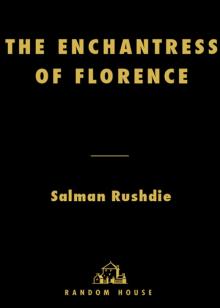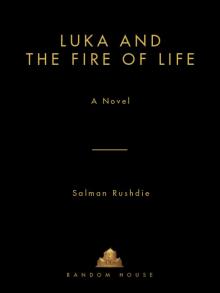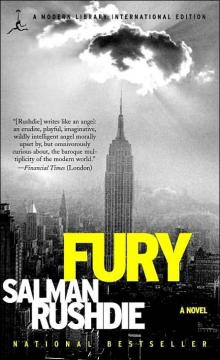- Home
- Salman Rushdie
The Enchantress of Florence Page 11
The Enchantress of Florence Read online
Page 11
It didn’t last long. Her beloved father the padishah or king soon met with a cruel fate. He had gone to the Akhsi fortress near Andizhan—ah, Akhsi, where the delicious mirtimurti melons grew!—Akhsi, painted by Dashwanth as being built on the very edge of a deep ravine—and while he was visiting his pigeons in their pigeoncote the ground gave way beneath his feet and the padishah, the pigeons, and the pigeoncote all tumbled into the ravine and were lost. Lady Black Eyes’ half-brother Babar became king at the age of twelve. She herself was still only four years old. In the midst of family tragedy and the chaos that followed it, the subject of Qara Köz’s power of occult Enlightenment was forgotten. Alanquwa the sun-goddess retreated once again to her proper place in the sky.
The fall of Umar Sheikh Mirza, the great-grandfather of the king of kings, was depicted with panache in one of Dashwanth’s finest works. The padishah was shown upside down against the blackness of the ravine, its stone walls rushing past him on either side, with the details of his life and character woven into the intricately abstract borders of the image: a short, fat man, good-natured and talkative, a backgammon player, a just man, but also a man who picked fights, a scarred paladin who knew how to punch, and, like all his descendants, like Babar, Humayun, Akbar, and Akbar’s sons Salim, Daniyal, and Murad, a man excessively fond of wine and hard liquor, and of the candy or sweetmeat called majun that was made from the cannabis plant and had led to his sudden demise. In a majun haze he had chased a pigeon too close to the edge of the cliff and then down he went, to that netherworld in which it mattered not if you were short or fat or good-natured or talkative or just, in which there were no backgammon partners or opponents to fight, and where the delirious haze of majun could surround a man through all eternity.
Dashwanth’s picture looked deep into the abyss and saw the demons waiting to welcome the king to their kingdom. The image was plainly an act of lèse-majesté, because even to suggest that the emperor’s ancestor might have fallen into the inferno was a crime punishable by death, containing as it did the suggestion that His Majesty might be headed the same way, but when Akbar saw the picture he simply laughed and said, “Hell sounds like a much more enjoyable place to me than all that tedium of angels by the side of God.” When the Water Drinker Badauni was told about this saying he concluded that the Mughal empire was doomed, because God would surely not tolerate a monarch who was turning into a Satanist before their very eyes. The empire survived, however, not forever, but for long enough; and so did Dashwanth, but for a much shorter time.
The next few years in the life of little Lady Black Eyes were an unsettled, wandering time, during which her brother and protector Babar galloped back and forth, winning battles, losing battles, gaining territory, losing it again, being attacked by his uncles, attacking his cousins, being rounded upon by his cousins, and attacking his uncles again, and behind all these ordinary family matters there waited the figure of his greatest enemy, the savage Uzbeg orphan, soldier of fortune and plague of the house of Timur, Wormwood—which is to say “Shaibani”—Khan. Dashwanth painted the five-, six-, and seven-year-old Qara Köz as a supernatural being cocooned in a little egg of light while all around her the battle raged. Babar captured Samarkand but lost Andizhan, then lost Samarkand, then recaptured it, and then lost it again, and his sisters with it. Wormwood Khan besieged Babar in that great city, and around the Iron Gate, the Needlemakers’ Gate, the Bleachers’ Gate, and the Turquoise Gate there was much hard fighting done. But in the end the siege starved Babar out. Wormwood Khan had heard the legend of the beauty of Babar’s elder sister Khanzada Begum and sent a message saying that if Khanzada was surrendered to him then Babar and his family could leave in peace. Babar had no choice but to accept, and Khanzada had no choice but to accept Babar’s choice.
Thus she became a sacrificial offering, human booty, a living pawn like the slave girls of Akbar’s pachisi court. However, in that last family gathering in the royal chambers of Samarkand, she added a choice of her own. Her right hand fell upon her little sister’s left wrist like the claw of a roc. “If I go,” she said, “I will take Lady Black Eyes to keep me company.” Nobody present could decide whether she spoke out of malice or love, because in Khanzada’s dealings with Qara Köz both emotions were always present. In Dashwanth’s picture of the scene Khanzada cut a magnificent figure, her mouth wide open as she cried her defiance, while Lady Black Eyes looked at first like a frightened child. But then those dark eyes drew you in and you saw the power lurking in their depths. Qara Köz’s mouth was open, too—she too was crying out, lamenting her misery and announcing her strength. And Qara Köz’s arm was extended also; her right hand, too, was fastened around a wrist. If Khanzada was to be Wormwood Khan’s prisoner, and she, Qara Köz, was to be Khanzada’s, then the little slave girl, the Mirror, would be hers.
The painting is an allegory of the evils of power, how they pass down the chain from the greater to the lesser. Human beings were clutched at, and clutched at others in their turn. If power was a cry, then human lives were lived in the echo of the cries of others. The echo of the mighty deafened the ears of the helpless. But there was a final detail to be observed: Dashwanth had completed the chain of hands. The Mirror, the slave girl, her left wrist captured in her young mistress’s firm grasp, with her free right hand had seized hold of Khanzada Begum’s left wrist. They stood in a circle, the three lost creatures, and by closing that circle the painter suggested that the clutch or echo of power could also be reversed. The slave girl could sometimes imprison the royal lady. History could claw upward as well as down. The powerful could be deafened by the cries of the poor.
As Dashwanth painted Qara Köz growing into the fullness of her young beauty during her captivity, it became plain that some higher power had captured his brush. The beauty of his canvases was so intense that Birbal, looking at them for the first time, presciently said, “I fear for the artist, for he is so deeply in love with this bygone woman that it will be hard for him to return to the present day.” The girl, the adolescent, the lambently beautiful young woman Dashwanth brought, or rather restored, to life in these masterpieces was, Akbar suddenly realized as he examined the work, almost certainly the qara ko’zum, the dark-eyed beauty celebrated by the “Prince of Poets,” the supreme versifier of the Chaghatai language, Ali-Shir Nava’i of Herat. Weave a nest for yourself in the depths of my eyes. O your slender body that resembles a young tree growing in the garden of my heart. At the sight of a bead of sweat on your face I may suddenly die. Dashwanth had actually painted a part of the last verse into the pattern of the fabric of Qara Köz’s garment. I may suddenly die.
Herat, the so-called “Florence of the East,” fell to Shaibani or Wormwood Khan soon after his capture of Samarkand, and it was where Khanzada, Qara Köz, and the Mirror spent most of their captive years. The world was like an ocean, people said, and in the ocean was a pearl, and the pearl was Herat. “If you stretch your feet in Herat,” Nava’i said, “you are sure to kick a poet.” O fabled Herat of mosques, palaces, and flying-carpet bazaars! Yes, it was a wonderful place, no doubt, the emperor thought, but the Herat which Dashwanth was painting, irradiated by the beauty of the hidden princess, was a Herat which no actually existing Herat could match, a dream-Herat for a dream-woman, with whom, as Birbal had divined, the artist was hopelessly in love. Dashwanth painted day and night, week in and week out, neither seeking nor accepting a day of rest. He became even scrawnier than usual and his eyes began to bulge. His fellow painters feared for his health. “He looks so drawn,” Abdus Samad murmured to Mir Sayyid Ali. “It’s as if he wants to give up the third dimension of real life and flatten himself into a picture.” This, like Birbal’s remark, was a piece of sharp observation, the truth of which quickly became apparent.
Dashwanth’s colleagues began to spy on him, because they had begun to fear he might do himself harm, so profound had his melancholy become. They took turns to watch him, and it wasn’t hard because he only had eyes for his work. They saw h
im succumb to the final madness of the artist, heard him pick up his pictures and embrace them, whispering Breathe. He was working on what would turn out to be the final picture of the so-called Qara-Köz-Nama, the Adventures of Lady Black Eyes. In this swirling transcontinental composition Wormwood Khan was dead in a corner, bleeding into the Caspian Sea, which swarmed with finny monsters. In the remainder of the picture Wormwood’s conqueror Shah Ismail of Persia greeted the Mughal ladies in Herat. The face of the Persian king bore an expression of wounded melancholy which reminded the emperor of Dashwanth’s own characteristic way of looking, and he surmised that this dolorous countenance might be the artist’s way of inserting himself into the tale of the hidden princess. But Dashwanth had gone further than that.
The simple fact was that in spite of the almost constant scrutiny of his peers he had somehow managed to vanish. He was never seen again, not in the Mughal court, nor anywhere in Sikri, nor anywhere in all the land of Hindustan. His body did not wash up on the shores of the lake, nor was it found hanging from a beam. He had simply disappeared as if he had never been, and almost all the pictures of the Qara-Köz-Nama had vanished with him, except for this last picture, in which Lady Black Eyes, looking lovelier than even Dashwanth had managed to make her look before, came face to face with the man who would be her destiny. The mystery was solved, inevitably, by Birbal. A week and a day after Dashwanth’s disappearance the wisest of Akbar’s courtiers, who had been scrutinizing the surface of the last remaining picture of the hidden princess in the hope of finding a clue, noticed a strange technical detail which had thus far gone undetected. It seemed as if the painting did not stop at the patterned borders in which Dashwanth had set it but, at least in the bottom left-hand corner, continued for some distance beneath that ornate two-inch-wide frame. The picture was returned to the studio—the emperor himself accompanied it, along with Birbal and Abul Fazl—and under the supervision of the two Persian masters the painted border was carefully separated from the main body of the work. When the hidden section of the painting was revealed the onlookers burst into cries of amazement, for there, crouching down like a little toad, with a great bundle of paper scrolls under his arm, was Dashwanth the great painter, Dashwanth the graffiti artist, Dashwanth the palanquin bearer’s son and the thief of the Qara-Köz-Nama, Dashwanth released into the only world in which he now believed, the world of the hidden princess, whom he had created and who had then uncreated him. He had pulled off an impossible feat which was the exact opposite of the one achieved by the emperor when he conjured up his imaginary queen. Instead of bringing a fantasy woman to life, Dashwanth had turned himself into an imaginary being, driven (as the emperor had been driven) by the overwhelming force of love. If the borderline between the worlds could be crossed in one direction, Akbar understood, it could also be crossed in the other. A dreamer could become his dream.
“Put the border back,” Akbar commanded, “and let the poor fellow have some peace.” When this had been done the story of Dashwanth was left to rest where it belonged, in the margins of history. At the center of the stage were the rediscovered protagonist and her new lover—the hidden princess Lady Black Eyes or Qara Köz or Angelica, and the Shah of Persia—standing face to face.
{ 10 }
A hanged man’s seed falls to the ground
A hanged man’s seed falls to the ground,” il Machia read aloud, “and there the mandrake will be found.” When Nino Argalia and his best friend Niccolò—“il Machia”—were boys together in Sant’Andrea in Percussina in the state of Florence they dreamed of having occult power over women. Somewhere in the woods of the region a man must have been hanged sometime or other, they decided, and for many months they hunted for mandrakes on Niccolò’s family property, the Caffagio oak wood and the vallata grove near Santa Maria dell’Impruneta, and also in the forest around the castle of Bibbione a little way away. They found only mushrooms and a mysterious dark flower that made them come out in a rash. At some point they decided the semen for the mandrake didn’t necessarily have to come from a hanged man, and after much rubbing and panting they managed to spill a few impotent drops of their own upon the uninterested earth. Then on Easter Sunday in their tenth year the Palazzo della Signoria was festooned with the swinging dead, eighty of the defeated Pazzi conspirators hanged from its windows that weekend by Lorenzo de’ Medici, including the archbishop in full regalia, and as it happened Argalia was staying in town with il Machia and his father Bernardo at their family house across the Ponte Vecchio, only three or four blocks away, and when they saw everyone running they could not be restrained.
Bernardo ran with the two boys, scared and excited at the same time, just like they were. Bernardo was a bookish man, boyish, sweet, and blood was distasteful to him, but a hanging archbishop was different, that was a sight worth seeing. The boys carried tin cups with them in case of useful drips. In the Piazza they ran into their pal Agostino Vespucci blowing loud raspberries at the murderous dead and making obscene masturbatory gestures at their corpses and shouting “Fuck you! Fuck your daughter! Fuck your sister! Fuck your mother and your grandmother and your brother and your wife and her brother and her mother and her mother’s sister too” at them as they twisted and stank in the breeze. Argalia and il Machia told Ago about the mandrake rhyme and he grabbed a cup and went and stood under the archbishop’s dick. Afterward in Percussina the three boys buried the two cups and recited what they imagined to be Satanic verses and then began a long, fruitless wait for the burgeoning of the plants of love.
“What begins with pendant traitors,” the emperor Akbar said to Mogor dell’Amore, “will be a treacherous tale.”
In the beginning there were three friends, Antonino Argalia, Niccolò “il Machia,” and Ago Vespucci. Golden-haired Ago, the most voluble of the trio, was one of a throng, a jostle, an argument of Vespuccis living cheek by jowl in the crowded Ognissanti district of the city, trading in olive oil, wine, and wool across the Arno in the gonfalone del drago, the district of the dragon, and he had grown up foul-mouthed and loud because in his family you had to be like that to get heard over the racket of all the fire-breathing Vespuccis yelling at one another like apothecaries or barbers in the Mercato Vecchio. Ago’s father worked for Lorenzo de’ Medici as a notary, so after that Easter of stabbings and hangings he was relieved to come out on the winning side. “But the fucking Pope’s army will come after us now because we killed the fucking priest,” Ago muttered. “And the fucking King of Naples’s army too.” Ago’s cousin, the wild twenty-four-year-old Amerigo or Alberico Vespucci, was soon packed off with his uncle Guido to get help for the Medici government from the King of France. From the light in Amerigo’s eyes as he set off for Paris it was easy to see that he was more interested in the journey than the king. Ago wasn’t the traveling kind. “I know what I’m going to be when I grow up,” he told his friends in the Percussina mandrake woods in which there were no mandrakes. “I’ll be a fucking sheep salesman or a booze merchant or else, if I get into the public service somehow, I’ll be a fucking ledger-scribbling no-account no-hope no-future fucking clerk.”
In spite of the bleakness of his clerical future Ago was full of stories. His stories were like Polo’s adventures, they were fantastic voyages, and nobody believed a word he said, but everybody wanted to listen, especially to his tall tales about the most beautiful girl in the whole history of the city, or possibly since the earth was formed. It was just two years since Simonetta Cattaneo, who married Ago’s cousin Marco Vespucci, known behind his back as Horned Marco or Marco the Fool of Love, had died of consumption and plunged all Florence into mourning, because Simonetta possessed a pale, fair beauty so intense that no man could look at her without falling into a state of molten adoration, and nor could any woman, and the same went for most of the city’s cats and dogs, and maybe diseases loved her too, which was why she was dead before she was twenty-four years old. Simonetta Vespucci was married to Marco but he had to share her with the whole town, which he did, at
first, with a resigned good grace that only proved his lack of brains to the citizens of that conniving, crafty locale. “Such beauty is a public resource,” he would say, with an idiotic innocence, “like the river, or the gold in the treasury, or the fine light and air of Tuscany.” The painter Alessandro Filipepi painted her many times, before and after she died, painted her clothed and naked, as the Spring and the goddess Venus, and even as herself. Whenever she posed for him she called him “my little barrel,” because she always mistook him for his older brother, whom people called “Botticelli”—“Little Barrels”—on account of his bulbous shape. The younger Filipepi, the painter, didn’t look like a barrel at all, but if that was what Simonetta wanted to call him it was all right by him, and so he started answering to the name.
Such was the effect of Simonetta’s powers of enchantment. She would turn men into whatever she wanted them to be, gods or lapdogs or little barrels or footstools or, of course, lovers. She could have ordered boys to die to prove their love of her and they would have done so gladly, but she was too good-natured for that, and never used her immense powers for ill. The cult of Simonetta grew until people were secretly praying to her in church, mumbling her name under their breath as if she was a living saint, and rumors grew of her miracles: a man struck blind by her loveliness as she passed him in the street, a blind man given sight when her sad fingertips were placed in a sudden gesture of pity upon his troubled brow, a crippled child rising to his feet to chase after her, another boy suddenly paralyzed when he made obscene gestures behind her back. Both Lorenzo and Giuliano de’ Medici were crazy about her and held a jousting tournament in her honor—Giuliano carried a banner bearing her portrait, painted by Filipepi and bearing the French legend la sans pareille, proving that he had beaten his brother to her hand—and they moved her into a suite of rooms in the palace, at which point even stupid Marco noticed that something was wrong in his marriage, but he was warned that if he protested it would cost him his life. After that Marco Vespucci became the only man in the city capable of resisting the beauty of his wife. “She is a whore,” he would say in the taverns he began to frequent to drown the knowledge of his cuckolding, “and to me she is as ugly as the Medusa.” Total strangers would beat him up for impugning the beauty of la sans pareille and in the end he had to stay home in Ognissanti and drink alone. Then Simonetta fell sick and died and it was said on the streets of Florence that the city had lost its enchantress, that a part of its soul had died with her, and it even became a part of the common parlance that one day she would rise again—that Florentines would never truly be themselves until her second coming, at which time she would redeem them all, like a second Savior. “But,” hissed Ago in the vallata wood, “you have no idea what Giuliano did to try to keep her alive: he turned her into a vampire.”

 Shame
Shame The Enchantress of Florence
The Enchantress of Florence Imaginary Homelands: Essays and Criticism 1981-1991
Imaginary Homelands: Essays and Criticism 1981-1991 Joseph Anton: A Memoir
Joseph Anton: A Memoir Midnight's Children
Midnight's Children East, West: Stories
East, West: Stories Luka and the Fire of Life
Luka and the Fire of Life Fury Fury Fury
Fury Fury Fury Haroun and the Sea of Stories
Haroun and the Sea of Stories Step Across This Line: Collected Nonfiction 1992-2002
Step Across This Line: Collected Nonfiction 1992-2002 The Satanic Verses
The Satanic Verses The Moor's Last Sigh
The Moor's Last Sigh The Prophet's Hair
The Prophet's Hair The Ground Beneath Her Feet
The Ground Beneath Her Feet Two Years Eight Months and Twenty-Eight Nights
Two Years Eight Months and Twenty-Eight Nights Shalimar the Clown
Shalimar the Clown Grimus
Grimus The Duniazát
The Duniazát Fury
Fury Quichotte
Quichotte The Jaguar Smile
The Jaguar Smile Joseph Anton
Joseph Anton Joseph Anton: A Memoir: A Memoir
Joseph Anton: A Memoir: A Memoir Imaginary Homelands
Imaginary Homelands The Satanic Verses: A Novel
The Satanic Verses: A Novel Step Across This Line
Step Across This Line East, West
East, West